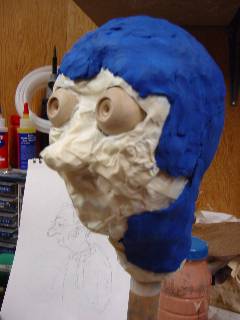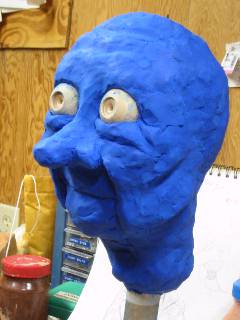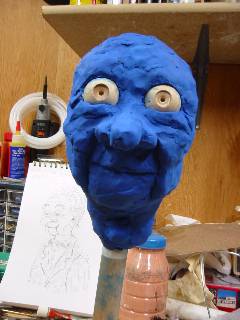Sculpting the Head
I won't try to teach how to sculpt here. I'm not even sure I know how. These are techniques that have worked for me in the past, techniques I learned by trial and error.
I apply a thin layer of clay to the armature to begin sculpting the head. The neck, top, and back don't involve much detailed sculpting; the armature defines the shape already.

Once the head is covered with clay, I begin adding features around the eyes, cheeks and mouth by pressing in small . This is when the figure's character starts to come out. I keep my sketches in view for reference.


This is a rough sculpture. The clay needs to be smoothed, and the image has several places that need improved details. The pictures show the head as it was late last night before I closed shop.
Notice that there are no ears. I will sculpt them after I cast the head shell from the plaster mold I will make from the clay sculpture. Ears are tricky to mold in plaster and cast in fiberglass because of undercuts. It's just as easy to do them last and glue them onto the head. If I planned to use an RTV mold, I could sculpt the ears now. But RTV is expensive and good for making production molds. Plaster of paris is cheap and good for making waste molds. Uncle Sweeter Dabney is a one-of-a-kind figure, so a plaster mold is the way to go.
I apply a thin layer of clay to the armature to begin sculpting the head. The neck, top, and back don't involve much detailed sculpting; the armature defines the shape already.

Once the head is covered with clay, I begin adding features around the eyes, cheeks and mouth by pressing in small . This is when the figure's character starts to come out. I keep my sketches in view for reference.


This is a rough sculpture. The clay needs to be smoothed, and the image has several places that need improved details. The pictures show the head as it was late last night before I closed shop.
Notice that there are no ears. I will sculpt them after I cast the head shell from the plaster mold I will make from the clay sculpture. Ears are tricky to mold in plaster and cast in fiberglass because of undercuts. It's just as easy to do them last and glue them onto the head. If I planned to use an RTV mold, I could sculpt the ears now. But RTV is expensive and good for making production molds. Plaster of paris is cheap and good for making waste molds. Uncle Sweeter Dabney is a one-of-a-kind figure, so a plaster mold is the way to go.










0 Comments:
Post a Comment
Subscribe to Post Comments [Atom]
<< Home